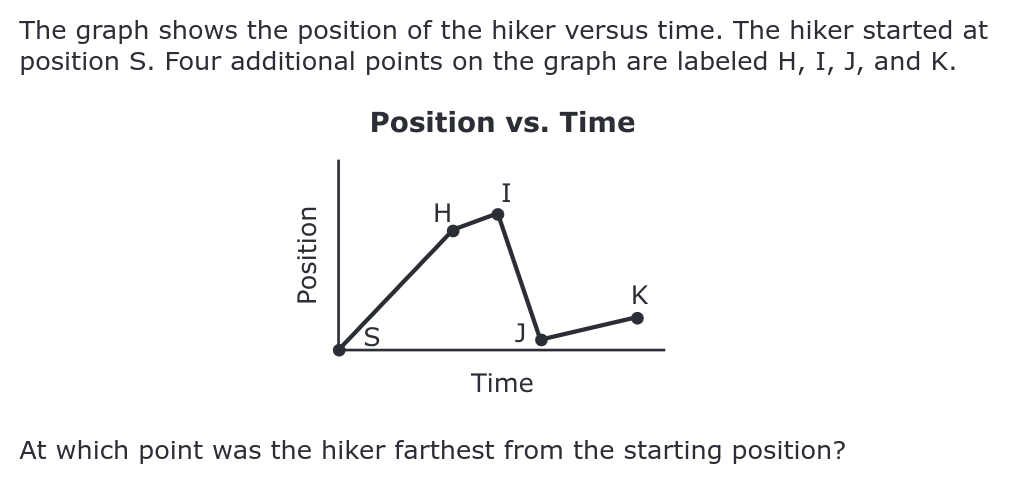1. Simple Motion
Overview
Simple motion is motion in a straight line at a constant velocity.Slides
Skills and Understanding
- Distinguish between distance and displacement.
- Distinguish between speed and velocity.
- Apply the equations for speed and velocity.
- Use the GUESS framework for problem solving.
Equations
\[ \begin{array}{ccc} \Delta x = x_{f} - x_{i} \quad \quad \quad \quad & s = \frac{d}{\Delta t} \quad \quad \quad \quad & v = \frac{\Delta x}{\Delta t} \quad \quad \quad \quad \end{array} \]Vocabulary
- Distance \(d\) is the total length of a path.
- Displacement is the change in position from the start to the end of a path. Given an initial position \(x_{i}\) and final position \(x_{f}\), the displacement \(\Delta x\) is calculated as \(\Delta x = x_{f} - x_{i}\)
- Speed is how fast something is moving. It is the rate of distance per time, and for distance \(d\) and change in time \(\Delta t\), speed \(s\) is calculated as \(s = \frac{d}{\Delta t}\)
- Velocity is the rate at which position is changing. It is calculated as \(v = \frac{\Delta x}{\Delta t}\)
1.1 Speed and GUESS
Given distance \(d\) and change in time \(\Delta t\), speed \(s\) is calculated with: \[s = \frac{d}{\Delta t}\] The GUESS method is a framework for problem solving. It stands for:- Givens — Identify the given values.
- Unknowns — Identify the unknown variables.
- Equation — Choose the appropriate equations.
- Substitute — Substitute known values into variables.
- Solve — Solve for the missing value.
The Givens are: \[ d = 15 \text{ km} = 15000 \text{ m} \] \[ \Delta t = 20 \text{ min} = 1200 \text{ s} \] The Unknown is: Speed \(s\).
The Equation to use is: \[ s = \frac{d}{\Delta t} \] We Substitute to get: \[ s = \frac{15000 \text{ m}}{1200 \text{ s}} \] And Solve to find: \[ s = 12.5 \text{ m/s} \]
1.2 Distance, Displacement, Speed, Velocity
Distance refers to the total length of a path, whereas displacement refers to the distance from the start to the end of a path. For example, if I walk \(6\) m forward and then \(10\) m backward, my distance traveled is \(16\) m while my displacement is \(-4\) m (that is 4 m behind where I started). Note that distance can never be negative but displacement can.
Speed is calculated using distance, \(s = \frac{d}{\Delta t}\), so it too can never be negative. Velocity on the other hand is calculated with displacement, \(v = \frac{\Delta x}{\Delta t}\), so it can be negative. Consider a car driving backward \(20\) miles in an hour. We would say that it's velocity is \(-20\) mph, but it's speed is \(20\) mph.
The Equations to use are: \[ \begin{array}{cc} s = \frac{d}{\Delta t} \quad \quad & v = \frac{\Delta x}{\Delta t} = \frac{x_{f} - x_{i}}{\Delta t} \end{array} \] We Substitute to get: \[ \begin{array}{cc} s = \frac{1168 \text{ m}}{540 \text{ s}} \quad \quad & v = \frac{518 \text{ m} - 0 \text{ m}}{540 \text{ s}} \end{array} \] And Solve to find: \[ \begin{array}{cc} s = 2.16 \text{ m/s} \quad \quad & v = 0.96 \text{ m/s} \end{array} \]
1.3 Position versus Time Graphs

Source: 2022 MCAS
A bit of nuance: it would be a mistake to choose point I only because it is the "highest" up the graph. The reason that point I is the correct answer is because it is furthest, and happens to be a positive value. If there were a point further away but in the negative direction, then the answer would be the "lowest" point down.

Source: 2022 MCAS
 1. Simple Motion
1. Simple Motion 2. Accelerated Motion
2. Accelerated Motion 3. Projectile Motion
3. Projectile Motion 4. Newton's Laws
4. Newton's Laws 5. Momentum
5. Momentum 6. Energy
6. Energy 7. Heat
7. Heat 8. Electrostatics
8. Electrostatics 9. Circuits
9. Circuits 10. Magnetism
10. Magnetism 11. Waves
11. Waves